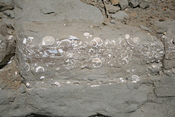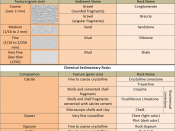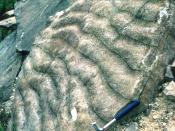Sedimentary Rocks � PAGE �4�
Sedimentary Rocks
Sedimentary Rocks
Sedimentary rocks are rocks, which are formed when parts of deceased organisms or pieces of rocks that already exist form deposits on the surface of the Earth. Sedimentary rocks have three main classifications. The classifications are biological sedimentary rocks, chemical sedimentary rocks, and clastic sedimentary rocks. Each sedimentary rock classification has characteristics that are apparent and are found in environments, which are depositional. Plate tectonics also have an adverse affect on the formation and sedimentation of sedimentary rocks.
Sedimentary rocks that are formed in a biological process are formed from the remains of living organisms, which have accumulated, have been compacted, and have been lithified (Boggs, 2006). Deposits from primitive plants form coal, and deposits of shells can either for coquina or limestone. When coal is formed from the deposits of plant material, it takes place mostly in swampland or in basins, which are closed fluvial.
When limestone, a carbonate rock, is formed there are two minerals, which are dominant, these two minerals are dolomite and calcite. These types of sedimentary rocks are found in basins of deposits (Middleton, 2003).
Sedimentary rocks that are formed in a chemical process are formed through chemical deposits. Chemical sedimentary rocks can include limestone, which can be biological or chemical, and gypsum and halite, which are evaporites (Boggs, 2006). Evaporites are sedimentary rocks, which are formed from the evaporation of water that has a mineral content that is high like sodium chloride. This formation can take place in an open or a closed system where the minerals are precipitated from the solution and form deposits. Halite, rock salt, can form deposits, which have been found to be at least 1,000 meters in thickness. These types of sedimentary rocks are found in basins of deposits...


